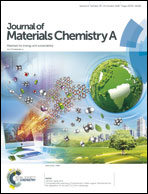An inorganic-MOF-inorganic approach to ultrathin CuO decorated Cu–C hybrid nanorod arrays for an efficient oxygen evolution reaction†
Abstract
Controllable design and synthesis are a great challenge to the fabrication of micro-/nano-structures of electrode materials in heterogeneous electrocatalysis. Herein, by virtue of an inorganic-MOF-inorganic (IMI) two-stage precursor approach, novel ultrathin CuO decorated Cu–C hybrid nanorod arrays supported on carbon fiber cloth (CFC) have been developed as highly efficient electrocatalysts for the oxygen evolution reaction (OER), and exhibit a current density of 10 mA cm−2 at an overpotential of 340 mV in 1.0 M KOH, ranking as one of the best copper-based OER catalysts. Further experimental results indicate that the ultrathin cupric oxide overlayers and special nanorod array morphology are crucial to boosting the electrocatalytic activity, which provides a new train of thought for utilizing low-cost and eco-friendly copper-based materials in energy storage/conversion.



 Please wait while we load your content...
Please wait while we load your content...